The recent report by Electricity Conservation and Supply Task Force and Independent Electricity Market Operator (IMO) forecast regarding acute power supply shortage in Ontario are wake up calls to take some immediate actions. It is the time to adopt strong strategies like Demand Side Management (DSM) to reduce this huge widening gap between its supply and demand at the earliest when sufficient supply options are not there.
Since its deregulation in May, 2002, the available generation in Ontario has not been adequate as compared to its demand. Ontario has been depending on costly electricity imports from its neighbors almost every month. These supply shortages and costly imports have lead to high electricity prices in the Ontario. Moreover, no new generation is coming up in Ontario as expected. While its present generation plants are aging and coal plants are being closed by the year 2007 due to environmental reasons, our supply side options are going to be exhausted and we are left with no other options than to opt for strong DSM measures to manage our demand to the maximum possible extent. Otherwise we are going to face severe reliability problems in the near future leading to huge economic losses.
While going for any technology, program or adopting any tool, there are always some driving forces or factors which should be present to opt for that. Following are the major driving factors which push for adopting DSM as a tool for a stable and efficient electricity market in Ontario:
Supply shortages lead to brownouts and blackouts creating reliability problems. This also leads to import costly electricity from outside. Both of these factors further contribute to high market prices creating an unstable and volatile market and putting uneconomical options for consumers. A deregulated market is the major platform to promote new programs like DSM because of the nature of this market structuredemanding a strong balance between supply and demand on real time basis. DSM through its tools like Demand/Load Response Programs and Time-of-Use rates has the capacity to create this balance more efficiently and timely rather than supply side management. In addition, the environmental concerns like reducing greenhouse gas emissions, saving natural resources and protecting environment is a big concern these days and most of our electricity generation plants are the major sources for environmental pollution.
All these driving factors are present in Ontario making it a strong case for adopting DSM. In the following sections we will examine the magnitude and significance of each of these factors.
Demand and Supply Position in Ontario:
Since its deregulation on May 1, 2002, Ontario’s generation resources availability has been below the expected levels especially when it experienced high demands. A number of times Independent Market Operator (IMO) controlling the Ontario Electricity Grid, was forced to issue power alerts due to insufficient reserve margins and had to make emergency purchases of energy at high prices.
The chart below shows that a summer peak of 25,414 MW in the month of August, 2002 and a new winter peak of 24158 MW was faced in January, 2003, breaking the previous record set nine years ago.
Against this demand, though Ontario has sufficient installed generation capacity, but all the generation is not available at all times. Other than the short time planned and forced outages, a major portion of around 5000 MW of its nuclear capacity has been laid-off since 1997-98 for refurbishing. Out of that, only 2000 MW has been on-line by February, 2004. Still 3000 MW nuclear capacity is off-line with no definite time to restart.
As per IMO data for the month of May, 2003, the following is the generation/supply from various sources:
Out of this capacity, Ontario government has proposed to close its 7400 MW coal fired plants by the year 2007 due to environmental reasons. In the next 20 years almost all of its nuclear plants and some of the other sources are going to complete their active operational life and will need either refurbishing or replacement. In addition to this, the demand in Ontario is increasing at the rate of average 1.7% per year which comes out to be another 8500 MW required in the next 20 years. So even if we add the proposed nuclear plants already planned for refurbishing along with a few other sources, even then there will be a huge gap between available and required supply and 25000 MW of new generation will be required as follows:
This huge gap can not be filled overnight. It will take years of planning, funding, commissioning and all that.
Electricity Imports in Ontario:
Ontario had to depend upon costly imports from its neighbors almost for all the months to meet its need. The cause of these heavy imports and supply shortage is stated to be the forced shut down of some generating plants and the delays in returning other generating stations to service as planned that had been taken out of service for routine maintenance.
As the following chart shows, these maximum imports varied between 910 MW in May, 2002 to 4273 MW in September, 2002. The average of these maximum imports since deregulation till December 2003 is around 2800 MW, which is 11% of its maximum demand. Except the first two months, the maximum import during every month has been above 10% of the monthly maximum demand.
Electricity Prices in Ontario
In Ontario’s electricity market the prices are set by the Independent Electricity Market Operator (IMO) through its real-time auction process for the supply of electricity.
The IMO sets the wholesale electricity prices by collecting offers from suppliers and bids from purchasers to determine on-the-spot market price for electricity. It uses these offers and bids to match electricity supply with demand, and establishes the Hourly Ontario Energy Price called HOEP. So energy prices change from time to time/hour to hour depending upon the system demand and available supply.
After deregulating the market, this price went high. Though this was due to initial unstable market, but due to public outcry, the Ontario government freezed the retail price to be paid by residential, commercial and other low volume designated consumers at 4.3 cents per Kwh in December, 2002.
Having a look at the following chart, we see that maximum HOEP since May 2002 has been as high as $1.02 per Kwh, i.e. 24 times higher than the fixed price of $ 0.04 per Kwh in September, 2002.
Even if we leave aside this maximum HOEP during the month which has been very volatile, and take the monthly weighted average of hourly market price, we find from the following chart that for most of the months the monthly weighted average price has been more than this fixed price.
After analyzing the maximum HOEP and Monthly Weighted Average Price of each month as compared to the fixed price, we see from the following chart that it was on an average 345 hours/times during a month (i.e. on an average 11 hours/times during a day) that the HOEP has been higher than the fixed price
What makes the prices volatile in a deregulated market:
It is the electricity technology and the economics of the electricity industry which contribute to the volatility of price in a deregulated market. Technically, electricity produced cannot be stored in economic ways, and its economics says that supply and demand must be kept in instantaneous balance to avoid high rising prices. So we should have a sufficient supply to meet with the rising demand or reduce demand as per the available supply on real time basis at every hour. So both these factors of supply shortage and rising demand create price volatility.
Environmental Concerns:
Canada’s commitment towards Kyoto protocol is another major factor to manage and control our demands and put less burden on our generating plants and new generation to fulfill our commitment towards environmental protection.
Significance of DSM in Ontario
As discussed above, that all the driving factors are present in Ontario with a huge magnitude and a deregulated market is there, providing a strong platform to implement these technologies. The excessive and costly monthly imports by Ontario, high rising prices and future generation shortages compel us to think whether to rely solely on our neighbors for help or to take serious initiatives for the solutions.
The provincial policies by this time are not attracting any good investments in new power generation plants and our old plants already aging, so we stand on the verge of facing severe power crises in the future. And by this time we are familiar with the huge economic losses faced due to blackouts.
Moreover, seeing the electricity price almost always above the fixed set price and growing burden on the tax payers in the shape debt due to subsidies by freezing price, Ontario needs strong DSM strategies.
Potential of DSM in Ontario
As we have seen above that the hourly import levels in Ontario since its deregulation has been on an average 11% of its maximum demand or around 2800 MW. So with a monthly maximum demand of around 25000 MW and more of its nuclear generation is already on-line by February, 2004, it is not an impossible task for Ontario to be self-reliant in power by using additional DSM techniques. So with a target of managing 5% of the maximum demand initially i.e. around 1250 MW and then 10% i.e. 2500 MW in the coming years through DSM will strongly enable Ontario to make a balance between its supply and demand, promote self-sufficiency and thus lead to stable electricity prices and a stable market.
Even in one of the statement by a representative of IMO, it was mentioned that Ontario has been able to reduce demand by as much as 4,500 megawatts at times. This reduction was an important contributor to avoid the need for rotational power outages in Ontario after blackout. However we have not adopted any strong DSM programs and policies by this time.
This proves the potential of DSM in Ontario and what we need is a dedicated and sincere approach by various segments of the Power Sector in the province.
How to control Price Volatility and Supply Shortages
Today’s electricity market has the two main components as "Technical"- related to supply reliability and "Economical"- related to affordable and stable electricity prices for consumers.
Both of these can be controlled either by Supply-Side Management by having sufficient supply availability to meet with rising demand or by Demand-Side Management (DSM) by curtailing electricity demand during times of supply shortages.
For short term measures the supply-side management is not effective as it takes long time for units to start up (if these are available) and meet the rising demand immediately, rather it is demand side management which can be implemented immediately and in more economic ways to keep the balance.
Moreover it is mentioned that- "Electricity saved is worth more than the electricity generated". One unit saved at consumer end is worth 1.10 units saved at the generator end, taking into account the long transmission and distribution line losses and all that.
Benefits of DSM:
The various benefits of DSM to consumers, enterprises, utilities, and society can be as:
We can achieve this by using various Techniques, Tools and Strategies for DSM as follows:
DSM Techniques
The most common DSM techniques can be classified as below:
Energy Conservation and Efficiency programs
Energy conservation and efficiency measures are the best alternative energy sources.
There are various opportunities and techniques available for reducing energy consumption. A lot is needed to change some of our electricity usage patterns which has a potential to reduce the overall supply consumption. Other than conservation, there are a number of energy efficient equipments almost for all the categories of consumers such as efficient lighting, variable speed drives, solar hot water systems etc. which can reduce demand, help in lowering high peak prices and also reduce greenhouse gas emissions due to less stress on generating plants. In addition, we have now many renewable and alternate supply sources available in many sizes to meet our needs and help reducing burden on the traditional system along with increasing reliability.
Dynamic/Real Time Pricing
The present deregulated market is based on real time system of supply and demand. Prices change time to time and hour to hour depending upon these two factors. By exposing customers to Real Time/Dynamic i.e. time-varying prices, they can have a better view of the prevailing market and the information and incentive to reduce their demand at peak times and to shift their usage from high priced periods to low-priced periods.
Time-of-Use Rates
This is the tool or rate structure by which customers are offered different rates for electricity usage at different times of the day. Offering them lower rates for consumption at off-peak time can make them aware and motivate to use some of the power at those low-priced times for some equipments which have the flexibility of operation at different times.
Automated/Smart Metering
Implementing Dynamic/ Real Time Pricing or Time-of-use rate structure and billing accordingly is not a complex program now. Automatic/Smart Metering successfully used by various utilities provides the best effective solution to this problem. This Automatic Meter Reading (AMR) system has various other benefits which are customer oriented as well as utility oriented.
Web-based/ Communication System
This is a tool used along with the above to convey the customer about the prevailing demand, supply and prices on real time basis and the related incentives and options, which are used by the customer to manage the demand. In addition, there are other methods like E-mail, Cell Phone, Pagers and Fax etc. which can be used as a communication tool to convey the required information and data to initiate appropriate action.
Market Drivers based Programs:
Depending upon the supply and market position, there are two broad categories based on the market drivers:
Reliability-based programs:
These programs operate in response to the system contingencies. That is why these can also be called as “contingency” programs. These are used whenever there is an emergency of power supply in case of acute shortage due to less generation or more demand or due to some other system constraints. These programs are also called Emergency Demand Response Program (EDRP).
Market/Price based programs:
These programs are based on market price signals of electricity. This category includes programs that use time-of-use (TOU) rates/Real Time Prices, Interruptible Rates and Two-part Tariff. These rates are intended to reduce consumer bills through the application of timedifferentiated rates. The consumer participants of these programs that curtail their loads at critical times of very high prices can also be paid some extra financial incentive to help maintain system reliability.
These programs can include Day Ahead Demand Response Program, where the end users respond to price signals and reduce loads when the price exceeds their set Base Price on day to day or day-ahead time basis as per demand, supply and price forecasts.
Types of Load Control:
The two main methods can be used to control the load at consumer premises depending upon the size of load and the infrastructure as:
Direct Load Control - Where load at the consumer’s facility is controlled directly by IMO/Utility operator in consultation with them after careful planning and installing required infrastructure. This is particularly suitable for large supply consumers.
Load Control by Consumer - Where only an information is sent to the consumer about the prevailing supply, demand and prices and quantity of load to be controlled and he has to take the action within the stipulated time
Participants of DSM/Load Response Programs
For implementing these programs, we need a strong government support through its various agencies. Ontario Energy Board (OEB), being a regulatory agency in the energy market, can play a leading role in promoting these programs.
Other than the Ministry of Energy and OEB, following are the key potential participants for these programs who can promote, implement and monitor these programs:
Factors effecting Load Response Programs:
However implementing these technologies and techniques is not always so cheap. Though there are many opportunities where we can apply them without any additional cost or investment. But to apply them at large scale for the whole market there are various factors to be considered as:
DSM Program Approaches:
Various approaches can be adopted to achieve benefits of Demand Side Management as:
DSM Programs Strategies
The following strategy may be adopted to design and implement DSM program:
Successful DSM Studies
We have many successful examples and models studies showing substantial benefits by adopting Demand Side Management tools and techniques.
It has been studied in U.S. that with universal application, peak energy demand could be lowered by at least 30,000 MW nationally, equivalent to perhaps as many as 250 peaking plants that would not need to be built. Society could avoid the burning of 680 bcf of gas per year and 31,000 tons of NOx emissions.
A study in 2002 showed that New York’s electricity market along with its grid operator and large electric utility companies has the potential to reduce demand for electricity by at least 1300 megawatts (MW) through Demand Side Management techniques, which is enough to supply power to 1.3 million homes.
Conclusion
DSM has the potential to provide significant economic, system reliability and environmental benefits.
From economic point of view, it can reduce dependency on expensive imports, reduce high energy prices and help in avoiding heavy investments in new generation transmission and distribution network to a good extent.
As per system reliability, it plays an important role in mitigating electrical system emergencies, avoiding blackouts, avoiding transmission grid congestion and so increasing system reliability.
DSM can help protect our environments by
saving our natural resources, reducing burden on our present generation plants leading to less greenhouse gas emissions and reduces the requirement of new generation.
DSM techniques are the cheapest, fastest and cleanest way to solve our electricity problems. These can be implemented immediately and many times most of the results can be achieved at one-tenth the cost of building new power plants.
This is what needed at this moment in Ontario along with its long term strategies to add new generation through various supply mix options to fill the wide gap in supply and demand. It is more significant especially when it is passing through the phase of uncertainty, already partially backed out from its deregulation policies by placing price caps, its aging existing power plants and very less new generation coming up. The strong presence of all the market drivers of DSM along with its sufficient potential make a strong case for its implementation in Ontario.
About the Author
Satish Saini has Bachelor’s Degree in Electrical Engineering with various professional development courses. He has extensive experience in managing Energy Programs, providing product and project support on Energy Efficiency and Management, Renewable Energy Sources, Power Distribution Automation, Demand Side Management and developing various engineering programs for professional development.
He has been an independent Unit Manager in a provincial Utility/Energy Supply Company with numerous accomplishments and achievements in various fields of planning, policy formation, business development, utility customer services, Power system commissioning, operation, maintenance and testing. He has managed more than 100 projects including prestigious National Level Pilot SCADA Projects in Distribution Automation and Energy Management.
He is an active member of various Professional Bodies like IEEE, Association of Energy Engineers USA, Institute of Power Engineers Canada, Ontario Society of Professional Engineers and many others. He is also associated with Canadian Standards Association in its three Technical Subcommittees on Energy Efficiency Projects. He is actively associating in Price Structure policies in a Deregulated electricity market, Demand Response Programs, development of Renewable energy sources in the current scenario and need of Power Distribution Automation in the utility industry.
He is a member of Council of Energy Advisors, USA and was awarded “Certificate of Recognition” by the Metropolitan Executive & Professional Registry for his professional achievements in 2003.
He can be contacted at: satishksaini@yahoo.com
Since its deregulation in May, 2002, the available generation in Ontario has not been adequate as compared to its demand. Ontario has been depending on costly electricity imports from its neighbors almost every month. These supply shortages and costly imports have lead to high electricity prices in the Ontario. Moreover, no new generation is coming up in Ontario as expected. While its present generation plants are aging and coal plants are being closed by the year 2007 due to environmental reasons, our supply side options are going to be exhausted and we are left with no other options than to opt for strong DSM measures to manage our demand to the maximum possible extent. Otherwise we are going to face severe reliability problems in the near future leading to huge economic losses.
While going for any technology, program or adopting any tool, there are always some driving forces or factors which should be present to opt for that. Following are the major driving factors which push for adopting DSM as a tool for a stable and efficient electricity market in Ontario:
- Supply shortage
- Costly imports
- High prices
- Deregulated market
- Environmental concerns
Supply shortages lead to brownouts and blackouts creating reliability problems. This also leads to import costly electricity from outside. Both of these factors further contribute to high market prices creating an unstable and volatile market and putting uneconomical options for consumers. A deregulated market is the major platform to promote new programs like DSM because of the nature of this market structuredemanding a strong balance between supply and demand on real time basis. DSM through its tools like Demand/Load Response Programs and Time-of-Use rates has the capacity to create this balance more efficiently and timely rather than supply side management. In addition, the environmental concerns like reducing greenhouse gas emissions, saving natural resources and protecting environment is a big concern these days and most of our electricity generation plants are the major sources for environmental pollution.
All these driving factors are present in Ontario making it a strong case for adopting DSM. In the following sections we will examine the magnitude and significance of each of these factors.
Demand and Supply Position in Ontario:
Since its deregulation on May 1, 2002, Ontario’s generation resources availability has been below the expected levels especially when it experienced high demands. A number of times Independent Market Operator (IMO) controlling the Ontario Electricity Grid, was forced to issue power alerts due to insufficient reserve margins and had to make emergency purchases of energy at high prices.
The chart below shows that a summer peak of 25,414 MW in the month of August, 2002 and a new winter peak of 24158 MW was faced in January, 2003, breaking the previous record set nine years ago.
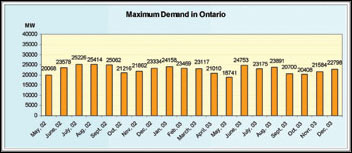
Against this demand, though Ontario has sufficient installed generation capacity, but all the generation is not available at all times. Other than the short time planned and forced outages, a major portion of around 5000 MW of its nuclear capacity has been laid-off since 1997-98 for refurbishing. Out of that, only 2000 MW has been on-line by February, 2004. Still 3000 MW nuclear capacity is off-line with no definite time to restart.
As per IMO data for the month of May, 2003, the following is the generation/supply from various sources:
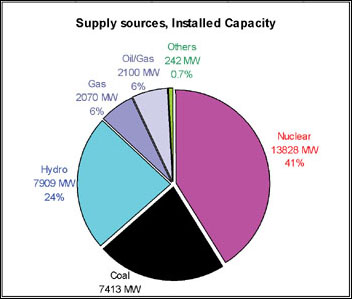
Out of this capacity, Ontario government has proposed to close its 7400 MW coal fired plants by the year 2007 due to environmental reasons. In the next 20 years almost all of its nuclear plants and some of the other sources are going to complete their active operational life and will need either refurbishing or replacement. In addition to this, the demand in Ontario is increasing at the rate of average 1.7% per year which comes out to be another 8500 MW required in the next 20 years. So even if we add the proposed nuclear plants already planned for refurbishing along with a few other sources, even then there will be a huge gap between available and required supply and 25000 MW of new generation will be required as follows:
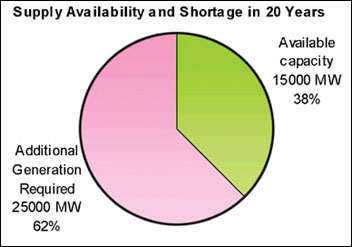
This huge gap can not be filled overnight. It will take years of planning, funding, commissioning and all that.
Electricity Imports in Ontario:
Ontario had to depend upon costly imports from its neighbors almost for all the months to meet its need. The cause of these heavy imports and supply shortage is stated to be the forced shut down of some generating plants and the delays in returning other generating stations to service as planned that had been taken out of service for routine maintenance.
As the following chart shows, these maximum imports varied between 910 MW in May, 2002 to 4273 MW in September, 2002. The average of these maximum imports since deregulation till December 2003 is around 2800 MW, which is 11% of its maximum demand. Except the first two months, the maximum import during every month has been above 10% of the monthly maximum demand.
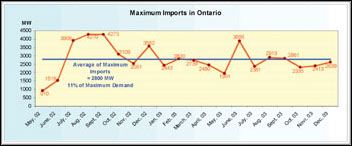
Electricity Prices in Ontario
In Ontario’s electricity market the prices are set by the Independent Electricity Market Operator (IMO) through its real-time auction process for the supply of electricity.
The IMO sets the wholesale electricity prices by collecting offers from suppliers and bids from purchasers to determine on-the-spot market price for electricity. It uses these offers and bids to match electricity supply with demand, and establishes the Hourly Ontario Energy Price called HOEP. So energy prices change from time to time/hour to hour depending upon the system demand and available supply.
After deregulating the market, this price went high. Though this was due to initial unstable market, but due to public outcry, the Ontario government freezed the retail price to be paid by residential, commercial and other low volume designated consumers at 4.3 cents per Kwh in December, 2002.
Having a look at the following chart, we see that maximum HOEP since May 2002 has been as high as $1.02 per Kwh, i.e. 24 times higher than the fixed price of $ 0.04 per Kwh in September, 2002.
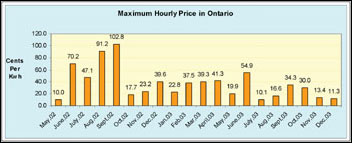
Even if we leave aside this maximum HOEP during the month which has been very volatile, and take the monthly weighted average of hourly market price, we find from the following chart that for most of the months the monthly weighted average price has been more than this fixed price.
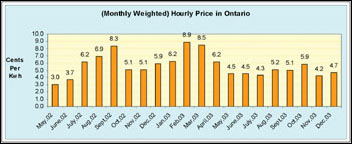
After analyzing the maximum HOEP and Monthly Weighted Average Price of each month as compared to the fixed price, we see from the following chart that it was on an average 345 hours/times during a month (i.e. on an average 11 hours/times during a day) that the HOEP has been higher than the fixed price
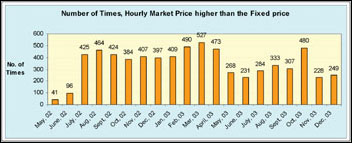
What makes the prices volatile in a deregulated market:
It is the electricity technology and the economics of the electricity industry which contribute to the volatility of price in a deregulated market. Technically, electricity produced cannot be stored in economic ways, and its economics says that supply and demand must be kept in instantaneous balance to avoid high rising prices. So we should have a sufficient supply to meet with the rising demand or reduce demand as per the available supply on real time basis at every hour. So both these factors of supply shortage and rising demand create price volatility.
Environmental Concerns:
Canada’s commitment towards Kyoto protocol is another major factor to manage and control our demands and put less burden on our generating plants and new generation to fulfill our commitment towards environmental protection.
Significance of DSM in Ontario
As discussed above, that all the driving factors are present in Ontario with a huge magnitude and a deregulated market is there, providing a strong platform to implement these technologies. The excessive and costly monthly imports by Ontario, high rising prices and future generation shortages compel us to think whether to rely solely on our neighbors for help or to take serious initiatives for the solutions.
The provincial policies by this time are not attracting any good investments in new power generation plants and our old plants already aging, so we stand on the verge of facing severe power crises in the future. And by this time we are familiar with the huge economic losses faced due to blackouts.
Moreover, seeing the electricity price almost always above the fixed set price and growing burden on the tax payers in the shape debt due to subsidies by freezing price, Ontario needs strong DSM strategies.
Potential of DSM in Ontario
As we have seen above that the hourly import levels in Ontario since its deregulation has been on an average 11% of its maximum demand or around 2800 MW. So with a monthly maximum demand of around 25000 MW and more of its nuclear generation is already on-line by February, 2004, it is not an impossible task for Ontario to be self-reliant in power by using additional DSM techniques. So with a target of managing 5% of the maximum demand initially i.e. around 1250 MW and then 10% i.e. 2500 MW in the coming years through DSM will strongly enable Ontario to make a balance between its supply and demand, promote self-sufficiency and thus lead to stable electricity prices and a stable market.
Even in one of the statement by a representative of IMO, it was mentioned that Ontario has been able to reduce demand by as much as 4,500 megawatts at times. This reduction was an important contributor to avoid the need for rotational power outages in Ontario after blackout. However we have not adopted any strong DSM programs and policies by this time.
This proves the potential of DSM in Ontario and what we need is a dedicated and sincere approach by various segments of the Power Sector in the province.
How to control Price Volatility and Supply Shortages
Today’s electricity market has the two main components as "Technical"- related to supply reliability and "Economical"- related to affordable and stable electricity prices for consumers.
Both of these can be controlled either by Supply-Side Management by having sufficient supply availability to meet with rising demand or by Demand-Side Management (DSM) by curtailing electricity demand during times of supply shortages.
For short term measures the supply-side management is not effective as it takes long time for units to start up (if these are available) and meet the rising demand immediately, rather it is demand side management which can be implemented immediately and in more economic ways to keep the balance.
Moreover it is mentioned that- "Electricity saved is worth more than the electricity generated". One unit saved at consumer end is worth 1.10 units saved at the generator end, taking into account the long transmission and distribution line losses and all that.
Benefits of DSM:
The various benefits of DSM to consumers, enterprises, utilities, and society can be as:
- Reduction in customer energy bills.
- Reduction in the need for new power plant, transmission, and distribution network
- Reduced grid congestion
- Increased efficiency, being at the consumer end due to the reason that less power has to travel through long transmission and distribution lines reducing line losses
- Stimulating economic development.
- Creating long-term jobs due to new innovations and technologies
- Increasing the competitiveness of local enterprises.
- Reduction in air pollution.
- Saving our natural resources
- Reduced dependency on foreign energy sources.
- Reduction in peak power prices for electricity leading to stable energy market
We can achieve this by using various Techniques, Tools and Strategies for DSM as follows:
DSM Techniques
The most common DSM techniques can be classified as below:
- Energy Conservation and Efficiency Programs- to save energy
- Demand/Load Response Programs- To shift and reschedule energy consumption process
Energy Conservation and Efficiency programs
Energy conservation and efficiency measures are the best alternative energy sources.
There are various opportunities and techniques available for reducing energy consumption. A lot is needed to change some of our electricity usage patterns which has a potential to reduce the overall supply consumption. Other than conservation, there are a number of energy efficient equipments almost for all the categories of consumers such as efficient lighting, variable speed drives, solar hot water systems etc. which can reduce demand, help in lowering high peak prices and also reduce greenhouse gas emissions due to less stress on generating plants. In addition, we have now many renewable and alternate supply sources available in many sizes to meet our needs and help reducing burden on the traditional system along with increasing reliability.
Dynamic/Real Time Pricing
The present deregulated market is based on real time system of supply and demand. Prices change time to time and hour to hour depending upon these two factors. By exposing customers to Real Time/Dynamic i.e. time-varying prices, they can have a better view of the prevailing market and the information and incentive to reduce their demand at peak times and to shift their usage from high priced periods to low-priced periods.
Time-of-Use Rates
This is the tool or rate structure by which customers are offered different rates for electricity usage at different times of the day. Offering them lower rates for consumption at off-peak time can make them aware and motivate to use some of the power at those low-priced times for some equipments which have the flexibility of operation at different times.
Automated/Smart Metering
Implementing Dynamic/ Real Time Pricing or Time-of-use rate structure and billing accordingly is not a complex program now. Automatic/Smart Metering successfully used by various utilities provides the best effective solution to this problem. This Automatic Meter Reading (AMR) system has various other benefits which are customer oriented as well as utility oriented.
Web-based/ Communication System
This is a tool used along with the above to convey the customer about the prevailing demand, supply and prices on real time basis and the related incentives and options, which are used by the customer to manage the demand. In addition, there are other methods like E-mail, Cell Phone, Pagers and Fax etc. which can be used as a communication tool to convey the required information and data to initiate appropriate action.
Market Drivers based Programs:
Depending upon the supply and market position, there are two broad categories based on the market drivers:
Reliability-based programs:
These programs operate in response to the system contingencies. That is why these can also be called as “contingency” programs. These are used whenever there is an emergency of power supply in case of acute shortage due to less generation or more demand or due to some other system constraints. These programs are also called Emergency Demand Response Program (EDRP).
Market/Price based programs:
These programs are based on market price signals of electricity. This category includes programs that use time-of-use (TOU) rates/Real Time Prices, Interruptible Rates and Two-part Tariff. These rates are intended to reduce consumer bills through the application of timedifferentiated rates. The consumer participants of these programs that curtail their loads at critical times of very high prices can also be paid some extra financial incentive to help maintain system reliability.
These programs can include Day Ahead Demand Response Program, where the end users respond to price signals and reduce loads when the price exceeds their set Base Price on day to day or day-ahead time basis as per demand, supply and price forecasts.
Types of Load Control:
The two main methods can be used to control the load at consumer premises depending upon the size of load and the infrastructure as:
Direct Load Control - Where load at the consumer’s facility is controlled directly by IMO/Utility operator in consultation with them after careful planning and installing required infrastructure. This is particularly suitable for large supply consumers.
Load Control by Consumer - Where only an information is sent to the consumer about the prevailing supply, demand and prices and quantity of load to be controlled and he has to take the action within the stipulated time
Participants of DSM/Load Response Programs
For implementing these programs, we need a strong government support through its various agencies. Ontario Energy Board (OEB), being a regulatory agency in the energy market, can play a leading role in promoting these programs.
Other than the Ministry of Energy and OEB, following are the key potential participants for these programs who can promote, implement and monitor these programs:
- Independent Electricity Market Operator (IMO) - controlling the electricity grid and large supply consumers
- Utilities/Suppliers - supplying electricity to consumers for medium and small supply
- Consumers - being the end user of electricity Each of these units has its own significant role to play. But the optimum results can be obtained by coordination of all of them. Government agencies can make various policies and regulations, provide incentives, subsidies and technical support for these programs and Utilities/suppliers can implement these programs more effectively through different cost-effective and customized options in coordination with the end-users i.e. the consumers.
Factors effecting Load Response Programs:
However implementing these technologies and techniques is not always so cheap. Though there are many opportunities where we can apply them without any additional cost or investment. But to apply them at large scale for the whole market there are various factors to be considered as:
- Cost to the customer to shed and reschedule the load
- Time it takes to activate the load response
- The variation in wholesale price
- Losses to occur otherwise in case of reliability problems due to acute shortage
- Any losses in production by implementing these programs
DSM Program Approaches:
Various approaches can be adopted to achieve benefits of Demand Side Management as:
- General information programs for customers about energy efficiency options.
- Information programs about specific DSM techniques appropriate for industry
- Financing programs to assist customers to pay for DSM measures
- Turnkey programs that provide complete services to design, finance, and install a package of efficiency measures at the consumer end.
- Alternative rate programs by the utilities like time-of-use rates and interruptible rates to shift loads to off-peak periods.
- Schemes and incentives to invest in energy conservation and efficiency programs
- Incentives for new innovations and technologies for Load Response/Load Management Programs.
DSM Programs Strategies
The following strategy may be adopted to design and implement DSM program:
- Identify the sectors and end-users as the potential targets
- Visualize the needs of the targeted sectors
- Develop the customized program
- Conduct analysis for cost-effectiveness
- Prepare marketing strategies for the program
- Develop a Project Execution Plan for its implementation
- Implement program
- Monitor program for its deliverables and for further modifications
Successful DSM Studies
We have many successful examples and models studies showing substantial benefits by adopting Demand Side Management tools and techniques.
It has been studied in U.S. that with universal application, peak energy demand could be lowered by at least 30,000 MW nationally, equivalent to perhaps as many as 250 peaking plants that would not need to be built. Society could avoid the burning of 680 bcf of gas per year and 31,000 tons of NOx emissions.
A study in 2002 showed that New York’s electricity market along with its grid operator and large electric utility companies has the potential to reduce demand for electricity by at least 1300 megawatts (MW) through Demand Side Management techniques, which is enough to supply power to 1.3 million homes.
Conclusion
DSM has the potential to provide significant economic, system reliability and environmental benefits.
From economic point of view, it can reduce dependency on expensive imports, reduce high energy prices and help in avoiding heavy investments in new generation transmission and distribution network to a good extent.
As per system reliability, it plays an important role in mitigating electrical system emergencies, avoiding blackouts, avoiding transmission grid congestion and so increasing system reliability.
DSM can help protect our environments by
saving our natural resources, reducing burden on our present generation plants leading to less greenhouse gas emissions and reduces the requirement of new generation.
DSM techniques are the cheapest, fastest and cleanest way to solve our electricity problems. These can be implemented immediately and many times most of the results can be achieved at one-tenth the cost of building new power plants.
This is what needed at this moment in Ontario along with its long term strategies to add new generation through various supply mix options to fill the wide gap in supply and demand. It is more significant especially when it is passing through the phase of uncertainty, already partially backed out from its deregulation policies by placing price caps, its aging existing power plants and very less new generation coming up. The strong presence of all the market drivers of DSM along with its sufficient potential make a strong case for its implementation in Ontario.
About the Author
Satish Saini has Bachelor’s Degree in Electrical Engineering with various professional development courses. He has extensive experience in managing Energy Programs, providing product and project support on Energy Efficiency and Management, Renewable Energy Sources, Power Distribution Automation, Demand Side Management and developing various engineering programs for professional development.
He has been an independent Unit Manager in a provincial Utility/Energy Supply Company with numerous accomplishments and achievements in various fields of planning, policy formation, business development, utility customer services, Power system commissioning, operation, maintenance and testing. He has managed more than 100 projects including prestigious National Level Pilot SCADA Projects in Distribution Automation and Energy Management.
He is an active member of various Professional Bodies like IEEE, Association of Energy Engineers USA, Institute of Power Engineers Canada, Ontario Society of Professional Engineers and many others. He is also associated with Canadian Standards Association in its three Technical Subcommittees on Energy Efficiency Projects. He is actively associating in Price Structure policies in a Deregulated electricity market, Demand Response Programs, development of Renewable energy sources in the current scenario and need of Power Distribution Automation in the utility industry.
He is a member of Council of Energy Advisors, USA and was awarded “Certificate of Recognition” by the Metropolitan Executive & Professional Registry for his professional achievements in 2003.
He can be contacted at: satishksaini@yahoo.com








